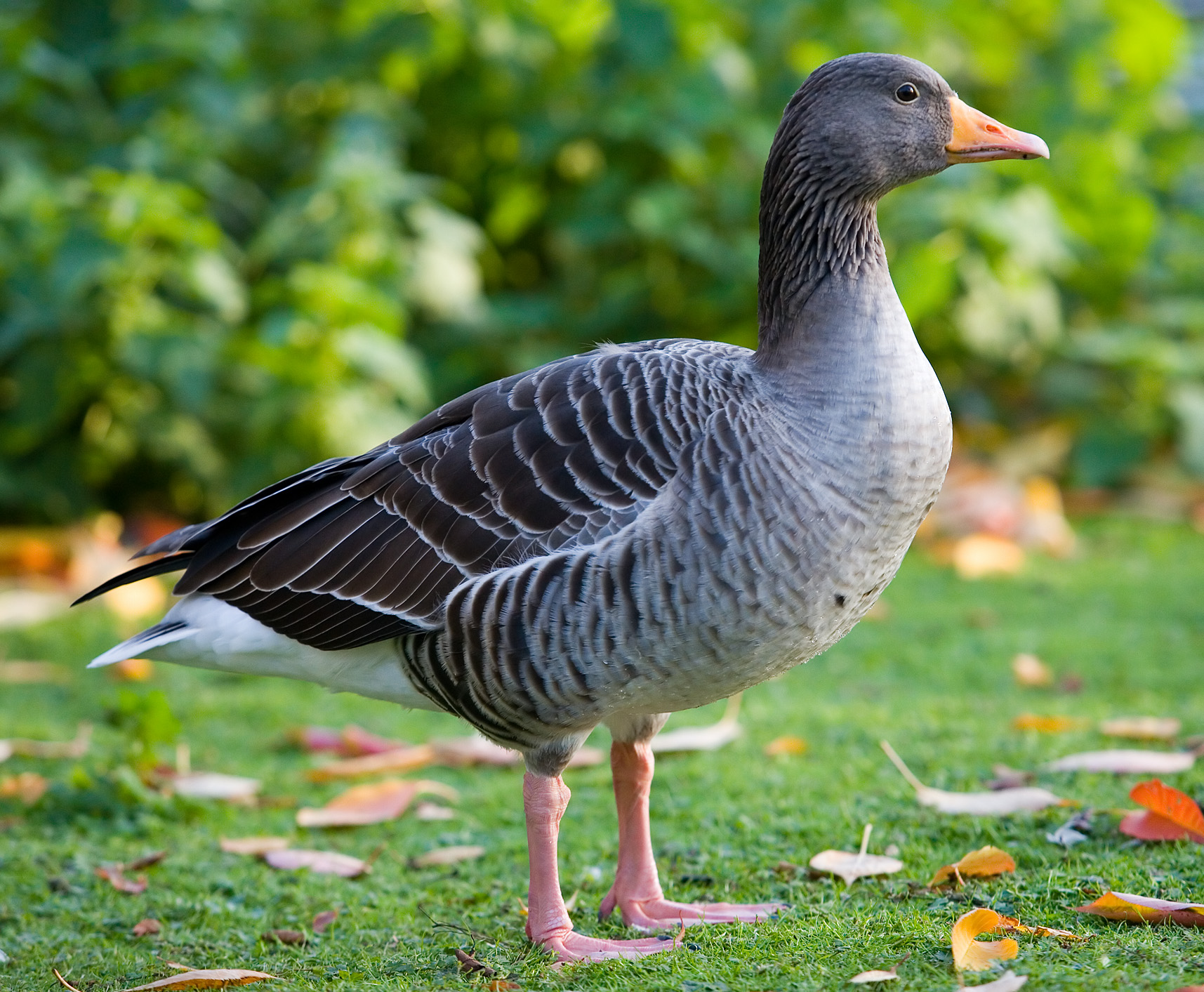- Greylag Goose
Taxobox
name = Greylag Goose
status = LC | status_system = IUCN3.1

image_width = 250px
image_caption = Western Greylag Goose ("Anser anser anser")
regnum =Animal ia
phylum = Chordata
classis = Aves
ordo =Anseriformes
familia =Anatidae
genus = "Anser"
species = "A. anser"
binomial = "Anser anser"
binomial_authority = (Linnaeus,1758 )
subdivision_ranks =Subspecies
subdivision =
* "A. a. anser" Western Greylag Goose
* "A. a. rubrirostris" Eastern Greylag Goose
* "A. a. domesticus"Domesticated goose The Greylag Goose, "Anser anser", is a
bird with a wide range in theOld World . It is thetype species of thegenus "Anser".It was in pre-Linnean times known as the Wild Goose ("Anser ferus"). This species is the ancestor of domesticated geese in
Europe andNorth America . Flocks offeral birds derived from domesticated birds are widespread.The Greylag Goose is one of the species to which the "Agreement on the Conservation of African-Eurasian Migratory Waterbirds" (
AEWA ) applies.Description
The Greylag is a large
goose , 74–84 cm (29–33 in) long with a 149–168 cm (59–66 in) wingspan and a body weight of 2.3–5.5 kg (5–12 lbs). It has a large head and almost triangular bill. The legs are pink, and the bird is easily identified in flight by the pale leading edge to the wing. It has a loud cackling call, "kiYAAA-ga-ga", like the domestic goose.The western European nominate subspecies, "A. a. anser", has an orange-pink bill and is slightly smaller and darker than the pink-billed Asian race, "A. a. rubrirostris". Eastern European birds are often intermediate in appearance.
Distribution and habitat
This species is found throughout the Old World, apparently breeding where suitable localities are to be found in many European countries, although it no longer breeds in southwestern Europe. Eastwards it extends across
Asia toChina .The geese are migratory, moving south or west in winter, but Scottish breeders, some other populations in northwestern Europe, and feral flocks are largely resident. This species is one of the last to migrate, and it is thought that "greaylag" signifies in English "late", "last", or "slow", as in "lag"gard, a loiterer, or old terms such as "lagman", the last man, "lagteeth", the posterior molar or "wisdom" teeth (as the last to appear), and "lagclock", a clock that is behind time. Thus the Greylag Goose is the grey goose, which in England when the name was given, was not strongly migratory but lagged behind the other wild goose species when they left for their northern breeding quarters.
In
Great Britain their numbers have declined as a breeding bird, retreating north to breed wild only in theOuter Hebrides and the northern mainland ofScotland . However during the 20th century, feral populations have been established elsewhere, and they have now re-colonised much ofEngland . The breeding habitat is a variety of wetlands including marshes, lakes, and damp heather moors.In
Norway , the number of greylag goose is estimated to have increased three- to fivefold during the last 15-20 years. As a consequence, farmers' problems caused by geose grazing on farmland has increased considerably. This problem is also evident for thepink-footed goose .Within science, the greylag goose is most notable as being the bird with which the ethologist
Konrad Lorenz first did his major studying into the behavioural phenomenon of imprinting.North America
In North America, small populations of Greylag Geese descended from domesticated geese have become established, mostly in city parks and near humans. These geese usually exist as part of larger flocks of Canada Geese. The Greylag Goose can hybridize with the native Canada Goose, producing birds which can be puzzling to birders attempting to identify them.
Notes and references
* Database entry includes justification for why this species is of least concern
* [http://www.nina.no/applications/system/publish/view/showLinks.asp?archive=1000890 Strong increase in the number of greylag goose in Norway] (PDF, in Norwegian, by the Norwegian Institute for Nature Research)External links
* [http://www.rspb.org.uk/birds/guide/g/greylaggoose/index.asp RSPB A to Z of UK Birds]
* [http://ibc.hbw.com/ibc/phtml/especie.phtml?idEspecie=425 Greylag Goose videos] on the Internet Bird Collection
* [http://www.birds.cornell.edu/crows/domgeese.htm Confusing Domestic Geese] - An article about Greylag geese in North America, with photos
* [http://www.birdsnetherlands.nl/oostvaardersplassen_greylag.htm the Greylag Goose in the Oostvaardersplassen] - An article about the Greylag Goose population in nature reserve Oostvaardersplassen, the NetherlandsGallery
Wikimedia Foundation. 2010.
